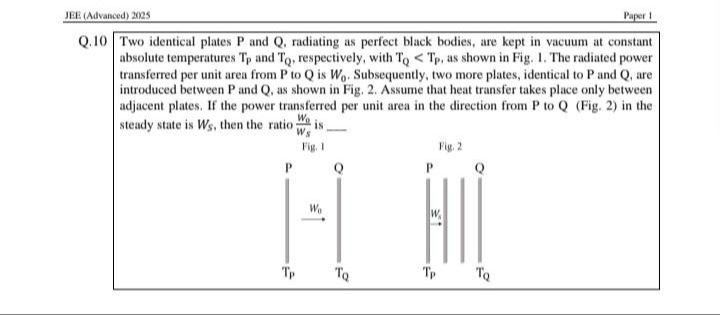Question
Question: Two identical plates P and Q, radiating as perfect black bodies, are kept in vacuum at constant abso...
Two identical plates P and Q, radiating as perfect black bodies, are kept in vacuum at constant absolute temperatures TP and TQ, respectively, with TQ<TP, as shown in Fig. 1. The radiated power transferred per unit area from P to Q is W0. Subsequently, two more plates, identical to P and Q, are introduced between P and Q, as shown in Fig. 2. Assume that heat transfer takes place only between adjacent plates. If the power transferred per unit area in the direction from P to Q (Fig. 2) in the steady state is WS, then the ratio WSW0 is ___.

3
Solution
In Fig. 1, two identical plates P and Q, radiating as perfect black bodies, are kept in vacuum at constant absolute temperatures TP and TQ, respectively, with TQ<TP. The radiated power transferred per unit area from P to Q is W0.
Since the plates are perfect black bodies, their emissivity is e=1. The power radiated per unit area by a black body at temperature T is σT4, where σ is the Stefan-Boltzmann constant.
The net power transferred per unit area from P to Q is the difference between the power radiated by P towards Q and the power radiated by Q towards P. Assuming they are parallel plates with large area, the net power transferred per unit area from P to Q is given by: W0=σTP4−σTQ4
In Fig. 2, two more plates, identical to P and Q, are introduced between P and Q. Let's call these intermediate plates R and S, placed between P and Q in the order P, R, S, Q. All plates are perfect black bodies. Let the temperatures of the intermediate plates in the steady state be TR and TS.
In the steady state, the net power transferred per unit area between any two adjacent plates is the same, say WS. Heat transfer takes place only between adjacent plates.
The net power transferred per unit area from P to R is WS=σTP4−σTR4. The net power transferred per unit area from R to S is WS=σTR4−σTS4. The net power transferred per unit area from S to Q is WS=σTS4−σTQ4.
From these equations, we have: σTP4−σTR4=WS σTR4−σTS4=WS σTS4−σTQ4=WS
Adding these three equations, we get: (σTP4−σTR4)+(σTR4−σTS4)+(σTS4−σTQ4)=WS+WS+WS σTP4−σTQ4=3WS
We know that W0=σTP4−σTQ4. So, W0=3WS.
The ratio WSW0=WS3WS=3.
